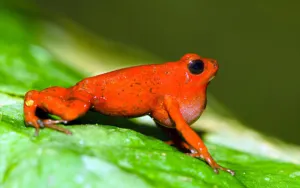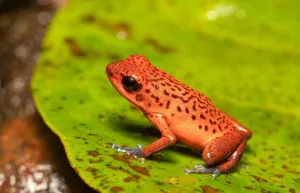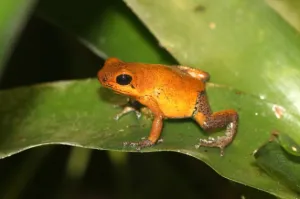
Table of Contents
Scientific Classification
- Kingdom: Animalia
- Phylum: Chordata
- Class: Amphibia
- Order: Anura
- Family: Dendrobatidae
- Genus: Oophaga
- Species: Various species, including Oophaga pumilio
Quick Overview
The Strawberry Poison Dart Frog (Oophaga pumilio) is a captivating and brightly colored amphibian found in the tropical rainforests of Central America. Belonging to the Dendrobatidae family, these frogs are renowned for their vibrant hues and potent skin toxins, which serve as a defense mechanism in the wild.
Fast Facts
- Scientific Name: Oophaga pumilio
- Lifespan: 3 to 5 years in the wild
- Average Size: Compact, typically ranging from 1 to 2 inches
- Diet: Insectivorous, consuming small invertebrates
- Habitat: Tropical rainforests, residing in leaf litter and low vegetation
- Conservation Status: Least Concern
Did you know?
The toxicity of Strawberry Poison Dart Frogs is believed to originate from the ants they consume in the wild.
Appearance
Strawberry Poison Dart Frogs exhibit a striking coloration, with shades ranging from vibrant red and orange to blue and green. This species showcases aposematism, a warning signal to potential predators about their poisonous nature. The bright colors vary among populations, and individual frogs may display unique patterns.
Size and Weight
These small frogs are generally compact, with an average size ranging from 1 to 2 inches. Despite their diminutive stature, their vibrant colors make them stand out in their natural habitat.
Temperament and Behavior
Strawberry Poison Dart Frogs are diurnal and known for their bold and active behavior. They are territorial, and males may engage in calling to establish dominance and attract mates. Their toxicity serves as a defense against predators in their native environment.
Fun Fact
Strawberry Poison Dart Frogs display parental care, with both males and females actively involved in caring for their offspring. The female lays eggs, and the male guards them until they hatch, transporting tadpoles to water-filled bromeliads.

Habitat and Distribution
Native to the rainforests of Central America, including regions like Costa Rica and Nicaragua, Strawberry Poison Dart Frogs thrive in the leaf litter and low vegetation of tropical environments. They are particularly associated with areas rich in bromeliads.
Care Guide
Due to their specific care requirements, Strawberry Poison Dart Frogs are recommended for experienced amphibian keepers. Captive care involves providing a well-designed vivarium with controlled humidity, suitable hiding spots, and a diet of small invertebrates.
Diet and Nutrition
In the wild, their diet consists of small invertebrates, particularly ants. In captivity, a diet of fruit flies, pinhead crickets, and other tiny prey items is essential for meeting their nutritional needs.
Health and Wellness
Maintaining optimal conditions in their enclosure, including proper humidity levels and a balanced diet, is crucial for the well-being of Strawberry Poison Dart Frogs. Regular monitoring helps prevent health issues.
Reproduction
Breeding behavior involves intricate courtship displays, and the male actively cares for the eggs and tadpoles. The toxic skin compounds are believed to be passed on to the tadpoles as a form of protection.
Conservation Status
As of now, Strawberry Poison Dart Frogs are listed as Least Concern by the International Union for Conservation of Nature (IUCN). Nevertheless, ongoing habitat loss and potential collection for the pet trade necessitate monitoring and conservation efforts.
Fun Fact
While their vibrant colors are a warning signal, individual frogs in different regions may exhibit variations in their color patterns, contributing to their visual diversity.
Photo Gallery




Related Profiles
Share This Profile
- Enchi Ball Python: A Unique and Stunning Morph of Python regius - March 27, 2025
- Emerald Tree Monitor: The Enigmatic Green Guardian of the Rainforest - March 26, 2025
- The Egyptian Cobra (Naja haje): A Fascinating Serpent - March 25, 2025
